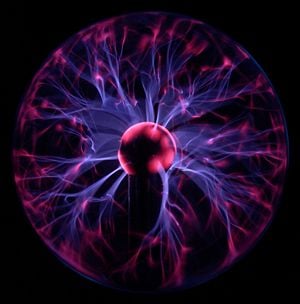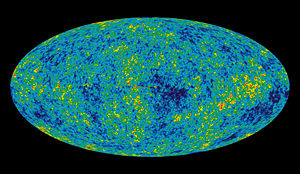Difference between revisions of "Anisotropy" - New World Encyclopedia
(moved images) |
|||
| Line 1: | Line 1: | ||
{{Claimed}} | {{Claimed}} | ||
| − | [[Image:Plasma-lamp 2.jpg|thumb|300px|right|The | + | [[Image:Plasma-lamp 2.jpg|thumb|300px|right|The filamentation from a [[plasma lamp]] indicates the anisotropic nature of [[Plasma (physics)|plasmas]].]] |
| − | '''Anisotropy''' | + | '''Anisotropy''' is a term used in various scientific fields to indicate that the values of certain properties depend on the direction from which they are measured. For example, the [[refractive index]] or [[density]] of a material may be different when measured along different axes. Such a material is said to be '''anisotropic'''.<ref>A "chemical anisotropic [[filter (chemistry)|filter]]," used for filtering particles, has a different meaning. This term is used to describe a filter with increasingly smaller interstitial spaces in the direction of filtration, so that larger particles are filtered out before the smaller ones. This type of filter results in greater flow-through and more efficient filtration.</ref> Anisotropy is the opposite of '''[[isotropy]]''', which indicates homogeneity of properties when measured from any direction. |
| − | == | + | ==Computer graphics== |
| − | + | In the field of [[computer graphics]], an anisotropic surface is one that changes in appearance when rotated about its geometric [[surface normal|normal]], as is the case with [[velvet]]. | |
| − | + | [[Anisotropic filtering]] (AF) is a method of enhancing the image quality of textures on surfaces that are far away and steeply angled with respect to the point of view. Older techniques, such as [[bilinear filtering|bilinear]] and [[trilinear filtering]], did not take into account the angle from which a surface is viewed, resulting in the blurring of textures. By reducing detail in one direction more than another, these effects can be reduced. | |
| − | + | ==Cosmology== | |
| − | + | [[Cosmologists]] use the term anisotropy to describe fluctuations in the [[cosmic microwave background radiation]] thought to be left over after the [[Big Bang]]. The term refers to the differences in the temperature of the radiation, depending on the direction of measurement. | |
===Physics=== | ===Physics=== | ||
[[image:WMAP.jpg|thumb|300px|[[WMAP]] image of the (extremely tiny) anisotropies in the [[cosmic background radiation]].]] | [[image:WMAP.jpg|thumb|300px|[[WMAP]] image of the (extremely tiny) anisotropies in the [[cosmic background radiation]].]] | ||
| − | |||
| − | |||
| − | [[ | + | In [[physics]], the term anisotropy may be used when referring to some properties of [[Plasma (physics)|plasmas]]. For example, a plasma may have a magnetic field oriented in a preferred direction, or show "filamentation" as seen in the case of [[lightning]] or a [[plasma globe]]. |
An anisotropic liquid is one which has the fluidity of a normal liquid, but has an average structural order relative to each other along the molecular axis, unlike water or [[chloroform]], which contain no structural ordering of the molecules. [[Liquid crystals]] are examples of anisotropic liquids. | An anisotropic liquid is one which has the fluidity of a normal liquid, but has an average structural order relative to each other along the molecular axis, unlike water or [[chloroform]], which contain no structural ordering of the molecules. [[Liquid crystals]] are examples of anisotropic liquids. | ||
| Line 37: | Line 35: | ||
===Material Science & Engineering=== | ===Material Science & Engineering=== | ||
| + | |||
Anisotropy describes the phenomena of [[chemical bond]] strengths being directionally dependent. Most materials exhibit anisotropic behavior, where the [[Young's Modulus]] depends on the direction of the load. | Anisotropy describes the phenomena of [[chemical bond]] strengths being directionally dependent. Most materials exhibit anisotropic behavior, where the [[Young's Modulus]] depends on the direction of the load. | ||
Anisotropy in polycrystalline materials can also be due to certain [[Texture (crystalline)|texture]] patterns which are often produced during manufacturing of the material. In the case of rolling, "stringers" of texture are produced in the direction of rolling, which can lead to vastly different properties in the rolling and transverse directions. | Anisotropy in polycrystalline materials can also be due to certain [[Texture (crystalline)|texture]] patterns which are often produced during manufacturing of the material. In the case of rolling, "stringers" of texture are produced in the direction of rolling, which can lead to vastly different properties in the rolling and transverse directions. | ||
| Line 44: | Line 43: | ||
Anisotropic etching techniques (such as [[Deep reactive ion etching]]) are used in microfabrication processes to create well defined microscopic features with a high aspect ratio. These features are commonly used in [[MEMS]] and [[microfluidic]] devices, where the anisotropy of the features is needed to impart desired optical, electrical, or physical properties to the device. | Anisotropic etching techniques (such as [[Deep reactive ion etching]]) are used in microfabrication processes to create well defined microscopic features with a high aspect ratio. These features are commonly used in [[MEMS]] and [[microfluidic]] devices, where the anisotropy of the features is needed to impart desired optical, electrical, or physical properties to the device. | ||
| + | |||
| + | == See also == | ||
| + | |||
| + | == Notes == | ||
| + | <references/> | ||
== External links == | == External links == | ||
Revision as of 21:56, 18 April 2007

Anisotropy is a term used in various scientific fields to indicate that the values of certain properties depend on the direction from which they are measured. For example, the refractive index or density of a material may be different when measured along different axes. Such a material is said to be anisotropic.[1] Anisotropy is the opposite of isotropy, which indicates homogeneity of properties when measured from any direction.
Computer graphics
In the field of computer graphics, an anisotropic surface is one that changes in appearance when rotated about its geometric normal, as is the case with velvet.
Anisotropic filtering (AF) is a method of enhancing the image quality of textures on surfaces that are far away and steeply angled with respect to the point of view. Older techniques, such as bilinear and trilinear filtering, did not take into account the angle from which a surface is viewed, resulting in the blurring of textures. By reducing detail in one direction more than another, these effects can be reduced.
Cosmology
Cosmologists use the term anisotropy to describe fluctuations in the cosmic microwave background radiation thought to be left over after the Big Bang. The term refers to the differences in the temperature of the radiation, depending on the direction of measurement.
Physics
In physics, the term anisotropy may be used when referring to some properties of plasmas. For example, a plasma may have a magnetic field oriented in a preferred direction, or show "filamentation" as seen in the case of lightning or a plasma globe.
An anisotropic liquid is one which has the fluidity of a normal liquid, but has an average structural order relative to each other along the molecular axis, unlike water or chloroform, which contain no structural ordering of the molecules. Liquid crystals are examples of anisotropic liquids.
Some materials conduct heat in a way that is isotropic, that is independent of spatial orientation around the heat source. It is more common for heat conduction to be anisotropic, which implies that detailed geometric modeling of typically diverse materials being thermally managed is required. The materials used to transfer and reject heat from the heat source in electronics are often anisotropic.
Many crystals are anisotropic to light (optical anisotropy), and exhibit properties such as birefringence. Crystal optics describes light propagation in these media. An axis of anisotropy is defined as the axis along which isotropy is broken (or an axis of symmetry, such as normal to crystalline layers). Some materials can have multiple such optical axes.
Geology
Seismic anisotropy is the variation of seismic wavespeed with direction. Seismic anisotropy is an indicator of long range order in a material, where features smaller than the seismic wavelength (e.g., crystals, cracks, pores, layers or inclusions) have a dominant alignment. This alignment leads to a directional variation of elasticity wavespeed. Measuring the effects of anisotropy in seismic data can provide important information about processes and mineralogy in the Earth; indeed, significant seismic anisotropy has been detected in the Earth's crust, mantle and inner core.
Geological formations with distinct layers of sedimentary material can exhibit electrical anisotropy; electrical conductivity in one direction (e.g. parallel to a layer), is different from that in another (e.g. perpendicular to a layer). This property is used in the gas and oil exploration industry to identify hydrocarbon-bearing sands in sequences of sand and shale. Sand-bearing hydrocarbon assets have high resistivity (low conductivity), whereas shales have lower resistivity. Formation evaluation instruments measure this conductivity/resistivity and the results are used to help find oil and gas wells.
Medicine
Anisotropy is also a well-known property in medical ultrasound imaging describing a different resulting echogenicity of soft tissues, such as tendons, when the angle of the transducer is changed. In diffusion tensor imaging, anisotropy alterations may reflect diffusion changes of water in the brain, particularly in the white matter.
Material Science & Engineering
Anisotropy describes the phenomena of chemical bond strengths being directionally dependent. Most materials exhibit anisotropic behavior, where the Young's Modulus depends on the direction of the load. Anisotropy in polycrystalline materials can also be due to certain texture patterns which are often produced during manufacturing of the material. In the case of rolling, "stringers" of texture are produced in the direction of rolling, which can lead to vastly different properties in the rolling and transverse directions. Some materials, such as wood and fibre-reinforced composites are very anisotropic, being much stronger along the grain/fibre than across it. Metals and alloys tend to be more isotropic, though they can sometimes exhibit significant anisotropic behaviour. This is especially important in processes such as deep-drawing.
Microfabrication
Anisotropic etching techniques (such as Deep reactive ion etching) are used in microfabrication processes to create well defined microscopic features with a high aspect ratio. These features are commonly used in MEMS and microfluidic devices, where the anisotropy of the features is needed to impart desired optical, electrical, or physical properties to the device.
See also
Notes
- ↑ A "chemical anisotropic filter," used for filtering particles, has a different meaning. This term is used to describe a filter with increasingly smaller interstitial spaces in the direction of filtration, so that larger particles are filtered out before the smaller ones. This type of filter results in greater flow-through and more efficient filtration.
External links
Credits
New World Encyclopedia writers and editors rewrote and completed the Wikipedia article in accordance with New World Encyclopedia standards. This article abides by terms of the Creative Commons CC-by-sa 3.0 License (CC-by-sa), which may be used and disseminated with proper attribution. Credit is due under the terms of this license that can reference both the New World Encyclopedia contributors and the selfless volunteer contributors of the Wikimedia Foundation. To cite this article click here for a list of acceptable citing formats.The history of earlier contributions by wikipedians is accessible to researchers here:
The history of this article since it was imported to New World Encyclopedia:
Note: Some restrictions may apply to use of individual images which are separately licensed.
